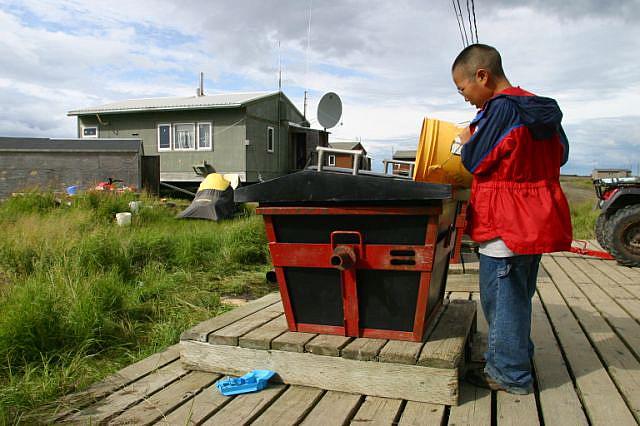For rural Alaskans, lack of running water and sewage a source of health problems
Kivalina, a remote village in northwest Alaska.
Alaska has the nation’s highest rate of people living without plumbing – 6 percent – and it’s getting worse.
My goal with the 2014 National Health Journalism Fellowship was to get the voices of people in rural Alaska who live without modern sanitation on the radio. They’re predominantly Alaska Native (Inupiaq and Yup’ik Eskimo and Athabascan Indian), and live in some three dozen communities with an average population of 300. I traveled to five communities for the series.
So what did I find out in remote northwestern and western Alaska? In villages without piped water and sewer, and where septic tanks and outhouses don’t work because of permafrost, people use a 5-gallon bucket fitted with a seat, known in Alaska vernacular as a “honey bucket,” as a toilet. They empty the bucket every day or so into a bunker or sewage lagoon. Some villages have a “flush haul” system where human waste goes into a home holding tank, which is then emptied periodically by a utility truck.
Honey buckets and flush haul systems both end up with human waste getting spilled and tracked around. Animals get into it. People drive through it. It dries and is scattered by the wind.
You would expect to see increased gastrointestinal problems from the handling of raw sewage, but that isn’t occurring. It’s the lack of running water that’s causing severe health problems.
People collect rain water. They buy treated water by the gallon from a central watering point, a washeteria. Or they haul water or ice from a river or lake. People said they haul water rather than buy it because they prefer the unchlorinated taste, but the fact it’s free also has to be a factor in villages with up to 25 percent unemployment. And after the water’s been used, they dump it outside.
When water comes at such effort or cost, people conserve its use. The average American uses 80 to 100 gallons of water a day, and uses a gallon of water each time for hand washing. A minimum of 15 gallons per day is considered necessary to stay clean and healthy. In underserved villages, people use an average of 2 gallons per person per day.
In some villages, the only option for human waste is to use “honeybuckets,” a bucket fitted with a toilet seat. It’s the chore of children to empty them.
That self-rationing is the source of the high rates of respiratory infections and skin infections in underserved communities. People put a couple of cups of soapy water in a basin and a couple of cups of clean water in another basin. All day, everyone in the household uses the same wash-water, which can become a soup of bacteria. Viruses spread easily in these conditions.
In underserved villages in the Yukon-Kuskokwim region, one in four babies is hospitalized for respiratory infections such as pneumonia and bronchiolitis. Rates of respiratory infections are 11 times higher than for other Alaskans. People in these communities also experience high rates of impetigo, cellulitis (infections of tissue underlying the skin), boils, and MRSA (antibiotic resistant) infections.
Between the small populations and the high cost of construction in remote villages, the cost of installing piped water and sewer systems can cost hundreds of thousands of dollars per capita. The state has launched a program to come up with lower-cost alternative systems, but officials don’t expect to have a field-tested prototype until 2018.
In the past few decades, some $2 billion has been spent on rural water and sewer, most of it federal funds. Some villages still have never had piped water and sewer; others have facilities that are past their operating life expectancy. A few villages have lost their water source, and some systems are threatened by collapse. Officials estimate it would take $900 million to meet the current need.
In 2014, the state allocated $7 million to rural water and sewer, the minimum needed to match federal grants. The overall state budget was $13.2 billion dollars. Of that larger sum, hundreds of millions of dollars went toward planning and development of projects that have been heavily criticized as unnecessary or unrealistic, such as a bridge with an estimated price tag of $5 billion that would go from Anchorage to vacant land across an inlet.
Alaska’s state budget is 95 percent oil revenues. In 2015, the price of oil dropped by half. The state Legislature is grappling with a $3 billion deficit. Federal funding is also declining.
The outlook for increased funding for water and sewer in rural Alaska is not promising. Meanwhile, the U.S. Army Corps of Engineers has identified about three dozen Alaskan communities that are at risk of losing vital infrastructure such as water and sewer systems and power plants due to the effects of climate change.
[All photos by Joaqlin Estus/KNBA]

